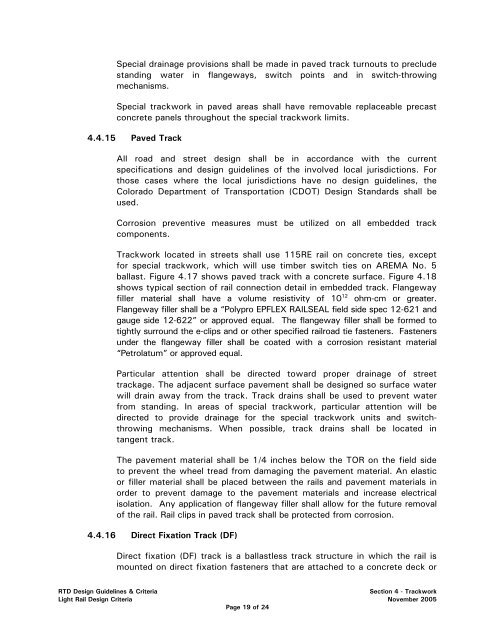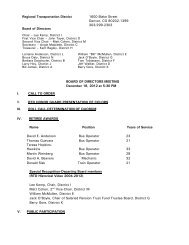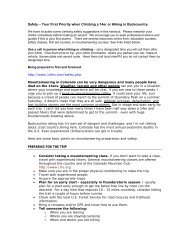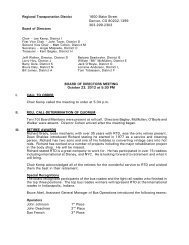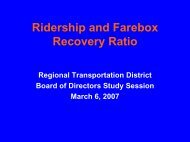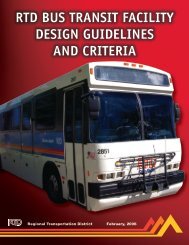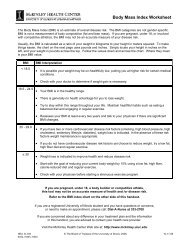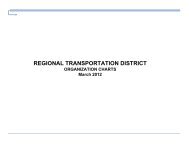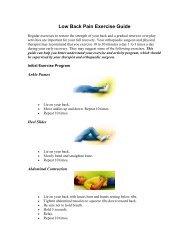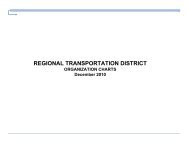RTD Light Rail Design Criteria
RTD Light Rail Design Criteria
RTD Light Rail Design Criteria
You also want an ePaper? Increase the reach of your titles
YUMPU automatically turns print PDFs into web optimized ePapers that Google loves.
Special drainage provisions shall be made in paved track turnouts to preclude<br />
standing water in flangeways, switch points and in switch-throwing<br />
mechanisms.<br />
Special trackwork in paved areas shall have removable replaceable precast<br />
concrete panels throughout the special trackwork limits.<br />
4.4.15 Paved Track<br />
All road and street design shall be in accordance with the current<br />
specifications and design guidelines of the involved local jurisdictions. For<br />
those cases where the local jurisdictions have no design guidelines, the<br />
Colorado Department of Transportation (CDOT) <strong>Design</strong> Standards shall be<br />
used.<br />
Corrosion preventive measures must be utilized on all embedded track<br />
components.<br />
Trackwork located in streets shall use 115RE rail on concrete ties, except<br />
for special trackwork, which will use timber switch ties on AREMA No. 5<br />
ballast. Figure 4.17 shows paved track with a concrete surface. Figure 4.18<br />
shows typical section of rail connection detail in embedded track. Flangeway<br />
filler material shall have a volume resistivity of 10 12 ohm-cm or greater.<br />
Flangeway filler shall be a “Polypro EPFLEX RAILSEAL field side spec 12-621 and<br />
gauge side 12-622” or approved equal. The flangeway filler shall be formed to<br />
tightly surround the e-clips and or other specified railroad tie fasteners. Fasteners<br />
under the flangeway filler shall be coated with a corrosion resistant material<br />
“Petrolatum” or approved equal.<br />
Particular attention shall be directed toward proper drainage of street<br />
trackage. The adjacent surface pavement shall be designed so surface water<br />
will drain away from the track. Track drains shall be used to prevent water<br />
from standing. In areas of special trackwork, particular attention will be<br />
directed to provide drainage for the special trackwork units and switchthrowing<br />
mechanisms. When possible, track drains shall be located in<br />
tangent track.<br />
The pavement material shall be 1/4 inches below the TOR on the field side<br />
to prevent the wheel tread from damaging the pavement material. An elastic<br />
or filler material shall be placed between the rails and pavement materials in<br />
order to prevent damage to the pavement materials and increase electrical<br />
isolation. Any application of flangeway filler shall allow for the future removal<br />
of the rail. <strong>Rail</strong> clips in paved track shall be protected from corrosion.<br />
4.4.16 Direct Fixation Track (DF)<br />
Direct fixation (DF) track is a ballastless track structure in which the rail is<br />
mounted on direct fixation fasteners that are attached to a concrete deck or<br />
<strong>RTD</strong> <strong>Design</strong> Guidelines & <strong>Criteria</strong><br />
Section 4 - Trackwork<br />
<strong>Light</strong> <strong>Rail</strong> <strong>Design</strong> <strong>Criteria</strong> November 2005<br />
Page 19 of 24


